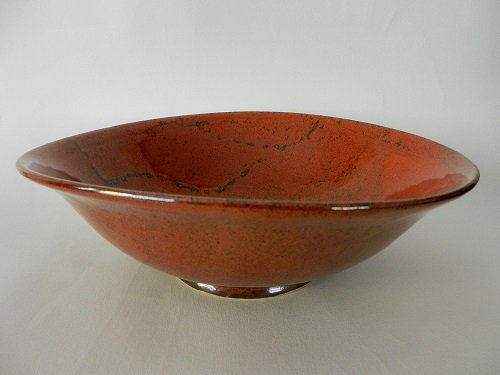I am still working on how to consistently get this gorgeous orange red. This is a potash feldspar/bone ash glaze with additions of iron oxide, as Michael Bailey sets out in his book Glazes, cone 6, 1240°C. He shows the gradations of colour obtained by increasing the amount of iron oxide by 1% each time.
Of course, there is always more to it than meets the eye. I’ve managed to get some wonderful results on test pieces, using 6%, 8% and 12%, but they don’t replicate on full-size pots, at least not consistently and not both inside and outside… Sometimes a thin layer of glaze is bright and successful, but when I actually dare to use on a piece, it’s all rather disheartening: often it comes out of the glaze kiln a dirty brown. And since I use shared workshop space with others, I am limited to the kiln temperature used by the group, 1260°C (so considerably higher than the specified cone 6).
Starting again this month, I have gone back to another workshop, where my former maître, Alain Losa, is teaching. They fire at 1250°, so closer to cone 6. I’m hoping that by re-doing my tests, measuring the specific gravity of the glaze, and picking his brains, I can make this work. People like orange-red, so if at first you don’t succeed…
So, you may be asking, how did you manage to get this glossy orange-red?
Luck. I refired the inside of this distorted (not bad, but in my opinion dirty brown) bowl a couple of weeks ago, recoating the inside with an orange-red at 12% iron oxide (I’d used 8% the first time). I did nothing to the outside, as it was pretty good as it was. I’m happy this time.
Fired in oxidation, to 1260°
